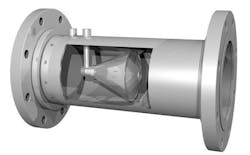A Pathway to Cleaner Energy: Optimal CO2 Metering Solution
As a key part of its mission to help conserve natural resources, McCrometer is positioned to assist with the increasing global demand for carbon capture and storage. This includes support for oil and gas companies that are striving to be good corporate citizens by meeting emissions standards. McCrometer V-Cone® technology is an ideal solution for these applications in oil and gas because of its ability to handle high pressures (up to 15,000 psi) and to be constructed from a variety of materials.
A major oil and gas producer in the Southeastern U.S. needed to implement enhanced oil recovery technology to boost production in a mature oil field. The company had been using waterflooding for the last 25 years, but it was no longer providing the desired output.
The company’s process engineers decided to implement a WAG injection system, which is designed to help increase oil recovery in mature reservoirs. (This field’s first well had been drilled in 1942.) WAG involves alternately injecting CO2 and water — the CO2 helps mobilize the remaining oil, while injecting water displaces the remaining oil and gas.
Company engineers required a flow meter to be installed as a master meter at the source tanks for CO2 and water. A stainless-steel piping split run was installed from the CO2 gas and water sources to support 16 well heads. A single master flow meter was required to measure both the CO2 gas and water flow as they went out to the well heads.
The engineers initially considered using a differential pressure technology orifice plate flow meter, but that created a problem. The installation area for the meter was already crowded with equipment, and the orifice plate flow meter required a long pipe straight-run to ensure accurate measurement. There simply wasn’t enough room to accommodate the orifice plate flow meter. Another consideration was the stainless-steel piping required at this specific well site. Stainless-steel piping is significantly more expensive than standard piping.
Because of its ability to perform in constrained spaces and measure both liquids and gases, the oil and gas company selected McCrometer’s V-Cone technology for the WAG project. Since then, the production improved from 350 to 4,500 barrels per day.
“We’ve used V-Cone flow meters in this application for three years without a single failure and no maintenance, and accuracy of the V-Cone has not changed a bit over time,” said the lead process engineer for the project.
Even with the split run fluid stream to the multiple well heads, the V-Cone flow meter remains accurate. This level of accuracy is significant because the process injects 70 million cubic feet of CO2 per day, but the gas remains in the ground and is reused in the process, which eliminates greenhouse gas pollution.
Editor's Note: Scranton Gillette Communications and the SGC Water Group are not liable for the accuracy, efficacy and validity of the claims made in this piece. The views expressed in this content do not reflect the position of the editorial teams of Water & Wastes Digest, Water Quality Products and Storm Water Solutions.
